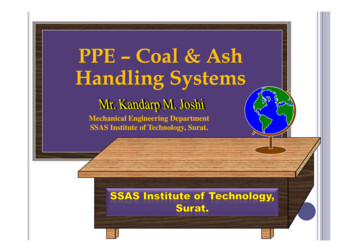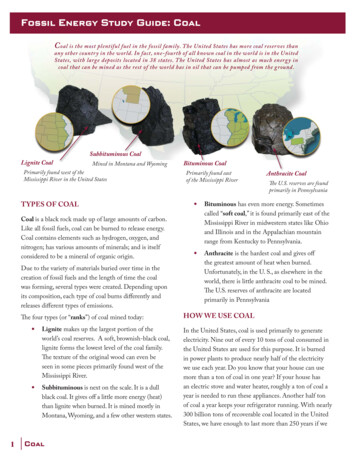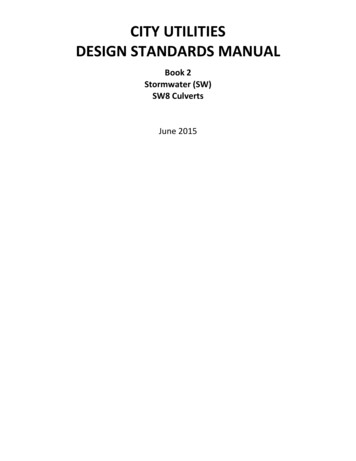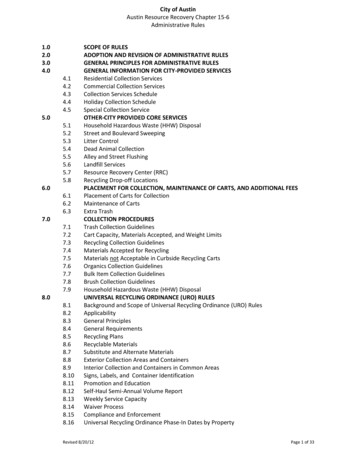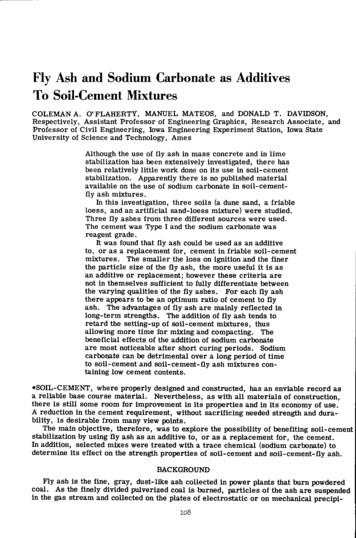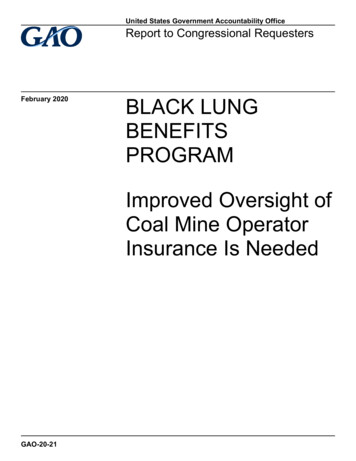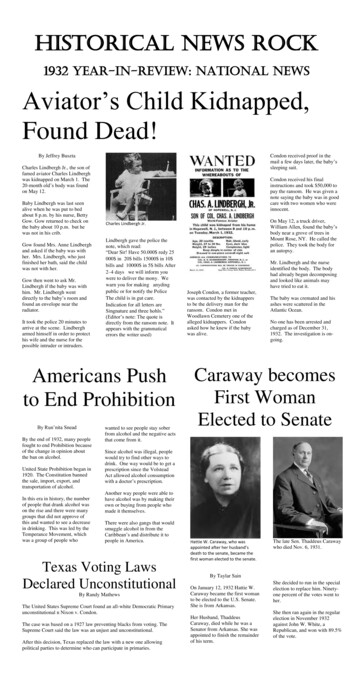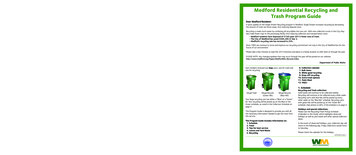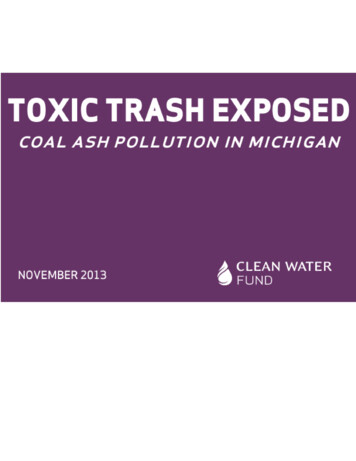
Transcription
Clean Water Fund is a national 501(c)(3) research and educationorganization that has been promoting the public interest since 1978.Clean Water Fund supports protection of natural resources, with anemphasis on water quality and quantity issues. Clean Water Fund’s organizing has empowered citizen leaders,organizations and coalitions to improve conditions of hundreds of communities, and to strengthen policies at all levelsof government. cleanwaterfund.orgClean Water Action is a national 501(c)(4) environmental organizationwith nearly one million members nationwide. Clean Water Action worksfor clean, safe and affordable drinking water, prevention of healththreatening pollution, creation of environmentally-safe jobs and businesses, and empowerment of people to makedemocracy work. Clean Water Action has organized strong grassroots groups, coalitions, and campaigns to protectour environment, health, economic well-being, and community quality of life. cleanwateraction.orgAcknowledgementsThe research and report were prepared by Susan E. Harley, J.D, Clean Water Fund Michigan’s Policy Director.Gouting Kang, HongYang Wang, Di Wu, Margie Ring, and Nick Parsons assisted in the preparation of this report.Clean Water Fund staff participating in the review include: Jennifer Peters, Lynn Thorp, Michael Kelly and NicClark. Special thanks to the Educational Foundation of America for funding this research.For an electronic copy of this report, visit: cleanwaterfund.org/mitoxictrashexposedOr contact:Clean Water Fund 2722 East Michigan Ave, Suite 201 Lansing, Michigan 48912 p: 517-203-0754E-mail: elansingcwa@cleanwater.orgFor more information on threats to Michigan’s waters, see Clean Water Action’s 2013-2014 Water Protection Agenda orcall Nic Clark, Michigan Director, at (517) 203-0754.2
Table of ContentsExecutive Summary . 4Overview: Dangers of Coal Ash . .6Coal-fired Electric Power Plants in Michigan .7Coal Ash Management in Michigan . . .9Beneficial Reuse Under Michigan Law .9State Regulations on Storage of Coal Ash .10Coal Ash Sites in Michigan .11Licensed Solid Waste Facilities .11Open Sites .11Closed Sites .11“Contained Waste” Storage Sites .12Part 201 Brownfield Sites .12Coal Ash Contamination in Michigan .13Clean-up Rules for Licensed Coal Ash Storage Areas 14Known damage cases .14Suspected contamination sites . 15Data Gaps .16Impoundment Structural Integrity and Dam Safety .16The Clean Water Act and Water Pollution from Coal Ash Sites .17Policy Recommendations 18Conclusion . 19Map: Coal Ash Disposal Sites in Michigan .21Appendix A: Known Part 201 Coal Ash Sites .22Appendix B: EIP Screening Tool Protocol .26Appendix C: Dossiers for Known Type III Damage Cases .27Appendix D: Dossiers for “Likely Contaminated” Coal Ash Sites .30Appendix E: Sites Where Contamination is Unknown .32Appendix F: Details on Dam Structural Integrity 33Appendix G: Tables 1-5 353
EXECUTIVE SUMMARYWater defines, and is central, to Michigan’seconomy. Major tourism, agriculture, and fishingindustries depend on the health of rivers, lakes, andstreams. The Great Lakes contain over 20% of theworld’s usable fresh surface water. 1 Unfortunatelyunmitigated coal ash pollution is a major threat tothe health of the state’s water and economy.More than 1.7 million tons of coal ash, the toxicbyproduct produced by coal-fired power plants, isgenerated every year in Michigan. Managing andstoring this amount of waste safely is a challenge andpresents health and environmental risks toMichigan’s communities. A lack of federal protections, weak state regulations, outdated andunregulated storage areas, and historic coal ash contamination sites threatens the state’s “PureMichigan” heritage and the Great Lakes.There are twenty-nine known coal ash sites in Michigan. Nineteen are within five miles of a GreatLake or a bay of a Great Lake, with several sitting directly adjacent to a bay. Three sites arewithin twenty miles of the Great Lakes. Every single coal ash impoundment or landfill sits on ornear one of the state’s lakes, rivers, streams, and wetlands.The Twenty-nine known coal ash sites in the state include several different types of sites: Nine open Type III Low Hazardous Industrial Waste landfills and surface impoundments,which are licensed by the state’s Office of Waste Management and RadiologicalProtection division (solid waste) at the Michigan Department of Environmental Quality(MDEQ.) Five all, or mostly closed, Type III Low Hazardous Waste Landfills and surfaceimpoundments. Nine “Contained waste” coal ash storage ponds that are completely unregulated by thestate’s solid waste authority, unless they meet the state’s definition of a dam. 2 There are a total of 20 open ponds spread across these nine sites. 3 4 Six historic coal ash storage areas classified by MDEQ as “Part 201” Brownfieldcontaminated sites.1See U.S Environmental Protection Agency (EPA) Great Lakes website: http://www.epa.gov/greatlakes/ basicinfo.html.Even though these ponds are unregulated by the solid waste department, many of these storage ponds are permitted to dischargewastewater into MI’s rivers, lakes and bays under the Clean Water Act.3Environmental Integrity Project (EIP) EPA FOIA output, June 26, 2010. (EIP FOIA output).4An additional 16 unregulated “contained waste” ponds are located at sites that also have regulated Type III landfills. Those sites areanalyzed in this report only as regulated storage areas.24
Of the fourteen sites that were regulated by the state at some point as Type III coal ash storage areas,twelve are either known to be contaminated or considered “likely contaminated.” MDEQ hasreported eight sites as contaminated to the U.S. Environmental Protection Agency (EPA). CleanWater Fund’s research found four additional “likely” contaminated sites. That’s nearly 86% of theregulated storage sites. There are an additional six known historic contamination sites that havebeen identified by the state as Part 201 Brownfield sites. Unfortunately, because of a lack of data, itis unknown whether numerous unregulated “contained waste” storage ponds are alsocontaminating the state’s water.In addition to the threats posed by leaking coal ash storage sites, there are other serious problemscreated by coal ash pollution. Several of the Brownfield sites include areas where coal ash washistorically disposed of in unlined pits or trenches as construction fill, which is allowed under“beneficial reuse” provisions of Michigan law. Disposing of coal ash in this manner exposes thesurrounding community to contamination during storm events. Moreover, the majority of powerplants in the state are allowed to discharge toxic pollution directly into the state’s water withoutlimiting harmful pollutants like mercury and lead.The state is not living up to the promise of “Pure Michigan.” The Governor’s 2014 2015Executive Budget provides the “Pure Michigan” tourism campaign with 29 million 5 from thestate’s general fund allocations. In contrast, the Michigan Department of Environmental Quality(MDEQ) is only allocated 28.1 million which must cover all of the department’s work includingoversight of solid waste and clean-up programs. 6 This limited funding for environmentalregulation puts Michigan’s water at risk.The state can and must do more to protect public health and water quality by overseeing handlingand disposal of coal ash and clean-up contaminated and leaking coal ash sites. Weak stateregulations are compounded by the absence of strong U.S. Environmental Protection Agency(EPA) rules addressing the long-term disposal of coal ash and water pollution from power plantcoal ash ponds. EPA risk assessments have long shown that the dangers of coal ash pollution andthe risks to human health and the environment are real. These assessments show the need forstrong regulations to prevent water and air pollution and to protect public health. However, inpractice, coal ash is less regulated than household trash.Coal ash contamination is preventable. Yet, without minimum federal standards to control thistoxic waste, coal ash will continue to be managed through a patchwork of weak state standards.This situation has allowed the water, air and land in at least 37 states to be poisoned, includingMichigan. EWS01/130619876/#“Moving Michigan Forward – Continuing Our Comeback: Executive Budget Recommendation for Fiscal Years 2014 and2015. See: michigan.gov/documents/reinvent/Governors FY 2014 budget recommendation FINAL 410798 7.pdf7Earthjustice. In Harm’s Way: Coal Ash Contaminated Sites. Available at: s-way-coal-ash-contaminated-sites. - Updated December 2012.5
Overview: The Dangers of Coal AshCoal ash is the general term for fly ash, bottom ash, coal slag, coal combustion waste, and coalcombustion residues. It also refers to Flue Gas Desulphurization (FGD) byproducts commonlycalled “scrubber sludge.” FGD is the process used to remove sulfur dioxide from power plantsmokestacks, which leaves behind a concentrated toxic sludge. As facilities install new scrubbers tocomply with federal air pollution regulations, the concentration of toxic chemicals and heavymetals in coal ash will increase. 8The toxic substances commonly found in coal ash, including mercury, lead, vanadium, selenium,and arsenic, are known to pollute water and air and pose public health risks. For example, a personwho drinks water polluted with arsenic has a cancer rate as high as one in fifty. 9 Lead, mercury,and other heavy metals in coal ash may cause developmental disabilities in fetuses and children. 10Coal ash may harm wildlife, too. Selenium can cause mutations in fish. 11 These toxic elements canmigrate from disposal sites and pollute the environment. Dry coal ash can blow away as “fugitivedust” and wet coal ash can percolate through soil and pollute drinking water. Coal ash also canmix with stormwater and drain directly into Michigan’s waterways.Compounding these risks is the sheer amount of waste produced by coal-fired power plants. TheEnvironmental Protection Agency (EPA) estimates that U.S. power plants produce 140million tons of coal ash annually – more toxic waste than any other industry. 12 Yet there are nofederal regulations to ensure communities and wildlife are protected from this toxic waste andmost state regulations are nonexistent or weak. This means that the majority of coal ash isdisposed of in unlined landfills or wet impoundments (often called ash ponds) while the restis used as construction fill or recycled in some other form.Many disposal sites lack adequate safeguards such as protective liners or groundwater monitoringand many of the impoundments are nothing more than earthen dams. This leaves nearbycommunities and wildlife at risk from potential large scale disasters, like the massive TennesseeValley Authority (TVA) coal ash spill in Tennessee in 2008 that dumped more than one billion8U.S. Congressional Research Service. “Managing Coal Combustion Waste (CCW); Issues with Disposal and Use.” 7-5700,January 12, 2010. Luther, L.9U.S. EPA. Hazardous and Solid Waste Management System; Identification and Listing of Special Waste; Disposal of CoalCombustion Residuals from Electric Utilities. Proposed Rule, June 21, 2010. Federal Register, Vol. 75, No. 118, page35145.10Agency for Toxic Substances and Disease Registry (ATSDR) ToxFAQs. roposed Rule, at 35171.U.S. Environmental Agency. 2010. Hazardous and Solid Waste Management Systems; Identification and Listing ofSpecial Wastes; Disposal of Coal Combustion Residuals from Electric Utilities; Proposed Rule, 75 Fed. Reg. 35128, June21, 2010.126
gallons of coal ash into the Emory and Clinch Rivers, destroyed three homes and damaged dozensmore. 13 This spill was caused when an unstable coal ash impoundment (or wet pond) failed.In response to the TVA disaster, on June 21, 2010, EPA proposed a rule to regulate coal ashdisposal under the Resource Conservation and Recovery Act (RCRA.) Nearly 450,000 peoplesubmitted comments in support of EPA’s proposal, including Clean Water Action members andsupporters who traveled to Chicago, IL to provide in-person comments to the EPA in support of astrong coal ash rule. However, more than three years later, a rule has yet to be finalized by theEPA.EPA’s proposed rule has been under constant attack by some members of Congress. Legislationhas been introduced multiple times to limit federal standards and enforcement by the EPA. TheU.S. Congressional Research Service has three times found these proposed bills to be inadequateto protect human health and the environment from the dangers of coal ash. 14“ [G}iven the potential gaps in existing state programs to regulate [Coal Combustion Residuals(CCRs)] CCRs, a program that would continue to allow states flexibility to regulate CCR disposal asthey deem necessary would not necessarily fill those gaps—potentially allowing waste managementpractices identified by EPA as those posing a risk to human health to continue.” --Excerpt from March2013 Congressional Research Service Report 15In addition to not adequately protecting water or health, these proposed bills fail to address how tomanage existing coal ash disposal sites such as leaking landfills and unregulated “contained waste”storage ponds. These proposals to block federal oversight coupled with a lack of deadlines forstates to set standards means there could be no improvements on the safety of coal ash storagesites. Instead of allowing EPA to set science and health based standards, the proposed legislationwould continue to rely on the weak patchwork of ineffective state laws that provide fewsafeguards to protect communities from harmful coal ash pollution.COAL-FIRED ELECTRIC POWER PLANTS IN MICHIGANElectric generation in Michigan is highly dependent on coal. More than 54% of the state’selectricity comes from coal fired power plants. 16 For example, Detroit Edison generatesapproximately 80% of its electricity from coal. 17Currently, there are 23 coal-fired power plants operating 18 in Michigan. Combined, the plantsproduce over 14,816 Megawatts (MW) of electricity annually and create millions of tons of13Evans, L., Becher, M and Lee, B. State of Failure: How States Fail to Protect Our Health and Drinking Water from ToxicCoal Ash. August 2011. Earthjustice. Available at: fFailure.pdf14“Analysis of Recent Proposals to Amend the Resource Conservation and Recovery Act (RCRA) to Create a CoalCombustion Residuals Permit Program”, March 19, 2013 (March 2013 CRS Report) and “H.R. 2273 and S. 3512: Analysisof Proposals to Create a Coal Combustion Residuals Permit Program Under RCRA”, December 5, 2012 (Dec. 2012 CRSReport).15March 2013 CRS Report at 45.16Energy Information Administration state data, see: http://www.eia.gov/state/?sid MI (last accessed 4/25/13)17See: ent/generation/generation.html7
pollution, including coal ash and toxic water pollution. Table 1 below includes specifics on coalash and toxic surface water pollution produced by Michigan’s power plants. Small plants areexempt from national reporting requirements and the state does not collect that type of data, sothe exact amount of coal ash produced annually in Michigan cannot be determined. However,according to the U.S. Energy Information Administration, over 1.7 million tons of ash is generatedannually by the 14 largest coal-fired power plants in the state. 19 For more information: See Table 1:Coal Fired Power Plant Pollution in Appendix GCoal Ash: Individual Plant Contributions (bythousand ton)Monroe, Detroit EdisonJ H Campbell, Consumers Energy71.662.15733.752.3 40.8Belle River, Detroit EdisonSt Clair, Detroit Edison7.2Trenton Channel, Detroit Edison78.7644.880.4Presque Isle, Wisconsin Electric PowerDan E Karn, Consumers Energy106.2River Rouge, Detroit Edison158.6171.9208.2J C Weadock, Consumers EnergyEckert Station, Lansing Board ofWater and LightJ R Whiting, Consumers EnergyB C Cobb, Consumers EnergyErickson Station, Lansing Board ofWater and LightHarbor Beach, Detroit Edison18The Marysville and SD Warren plants have been decommissioned. However, this report does not address whether thecoal ash at these sites has been remediated.19Data compiled from Energy Information Administration, “Power Plant Operations Report,” (Form EIA-923), October 25,2011.8
COAL ASH MANAGEMENT IN MICHIGANToxic coal ash dumps are scattered across the state’s two peninsulas. All of these sites are locatedon or very near lakes, rivers, streams, or wetlands. Under Michigan law and MDEQ regulationscoal ash can be disposed of in a variety of ways including: Used as construction fillDisposed of in municipal landfills.Disposed in low-hazardous industrial waste landfills and surface impoundments.Stored in “contained waste” piles and surface impoundments (ponds).Beneficial Reuse under Michigan LawUnder current state law, coal ash is exempt from solid waste requirements if it meets certainspecifications for “reuse.” 20 However, that includes allowing it to be used as fill in road orconstruction projects, creating the potential for contaminants to seep and enter ground or surfacewater.There are two types of reuse: Encapsulated and Unecapsulated. Encapsulated reuse chemicallybinds ash with another substance, like concrete. In theory, encapsulating coal ash will keep it frommigrating into soil, surface, and ground water. There is still a need to test encapsulated uses overtime for radiation levels and toxic leaching, but in general this practice is thought to be lessharmful than unencapsulated uses.Unencapsulated reuse of coal ash, like construction fill or road base or agricultural applications arenot considered to be “beneficial” by EPA. Over one quarter of the known coal ash damage casescited by the EPA in its 2010 proposed rule were caused by unencapsulated coal ash reuse. Forexample, in Pines, Indiana, drinking water wells were contaminated by arsenic and other harmfulsubstances because coal ash was used as fill under new roads and construction sites around thecity. 21Despite the risks to public health and the environment from unencapsulated coal ash reuse, it isallowed under Michigan state law if it meets certain specifications. 22 These requirements disposal depths must be greater than four feet from the seasonal water table and ash must becovered with impermeable substances (though that can be waived by the MDEQ) – seemprotective, but in practice there are no real safeguards for human health from leachingcontaminants. For example, there are no requirements that fill areas be lined, that leachate bedrained and collected, or that nearby ground or surface water be monitored for contamination.20MCL 324.11506See: “Not in My Lifetime” report.22R 299.4113219
The State’s Office of Regulator Reinvention and certain lawmakers want to expand theunencapsulated reuse of coal ash, and other harmful industrial waste products like cement kilndust. These proposals would allow the unencapsulated coal ash to be used in road shoulderscovered with permeable gravel or applied to agricultural fields. Such uses are dangerous andshould be avoided. Instead of weakening protections Michigan should move forward withregulations that only permit encapsulated coal ash reuse while beginning a long term study of suchmethods for safety.Michigan Department of Environmental Quality Regulations on Disposal of Coal AshIn addition to reuse, Michigan allows coal ash to be disposed of in dry landfills or wet storageponds, most of which are unlined or lined only with clay. These permanent disposal facilities arecalled “Type III 23 Low Hazardous Industrial Landfills” and are licensed under the state’s solidwaste program. However, many of these permanent disposal sites were “grandfathered-in” sorequirements for solid waste landfills don’t apply. 24 These sites have no synthetic liners, 25 liquidwaste seepage, or leachate collection 26. Current Michigan regulations allow low permeabilitysoil, 27 clay, and other natural liners to be used for even new Type III landfills. 28“Contained waste” piles of coal ash are typically ponds that are unregulated by the state, 29 unlessdam safety requirements apply. Under Michigan rules, the “storage of solid waste in a pile shallnot constitute disposal if the pile has a containment system that is designed, installed, and operatedto prevent any migration of accumulated liquids out of the system to the soil, groundwater, orsurface water at any time during the use of the system.” 30 Certain specifications must be met forwaste pile containment, such as ensuring the pressure of the liquid waste can be endured. This hasallowed waste ponds to exist at most, if not all, of the state’s power plants without state oversight,though several plants have associated solid waste landfills that are regulated or sought regulationfor an impoundment.In Michigan, coal ash may also be disposed in municipal landfills 31 designed for household trash.Municipal solid waste landfills are required to install liners and systems to collect leachate tominimize water pollution and to monitor nearby water quality. Unfortunately these requirementsare designed for household trash, not the contaminants in coal ash waste. Due to inadequaterecord-keeping the state does not know how much coal ash is being disposed of in solid wastelandfills or whether this ash is polluting water near landfill sites.23For locations see Google map (Type III) open locations:http://www.michigan.gov/documents/deq/MI Part115 Actives 343663 7.kml?rand 661124R 299.4301 R 299.4302 Appendix AUnless lateral expansion of existing landfill. See R 299.4307(1) Appendix A26Leachate collection systems R 299.4308 exempt some natural soil “lined” Type III landfills. See Appendix A.27Soil must have a maximum demonstrated hydraulic conductivity of 1.0 X 10-7 cm/sec, R 299.430728R 299.4307 Appendix A29R 299.413030R 299.413031R 299.4311 Appendix A2510
COAL ASH SITES IN MICHIGANIn Michigan, there are twenty-nine known coal ash sites; twenty three are impoundments or pondsand six are “Part 201” Brownfields. The majority of these sites are within a short distance of theGreat Lakes and all of the sites are located on or very near bays, rivers, or wetlands. Many sites arebordered by water and some are near stormwater drains that channel runoff into streams, rivers,and other surface water.The twenty-three coal ash storage sites in Michigan include three different types of sites:regulated Type III landfills, both open and closed; regulated Type III surface impoundments, orponds, both open and closed; and lastly, unregulated “contained waste” storage sites.Licensed Solid Waste FacilitiesOpen Type III Coal Ash sitesType III Low Hazardous landfills are monitored by the state’s Office of Waste Management &Radiological Protection and must in theory meet solid waste disposal requirements. Howevermany of these sites are exempted from requirements, such as waivers for ongoing water qualitytesting and discontinuation of all testing for certain contaminants.There are nine open Type III sites in the state, used primarily for coal ash storage: DE Karn inEssexville, JC Weadock in Essexville, JH Campbell in West Olive, JR Whiting in Erie, MonroePower Plant in Monroe, Presque Isle Power Plant in Marquette, Range Road landfill in ChinaTownship, Sibley Quarry in Trenton, and Zeeland Township in Zeeland. The Campbell,Whiting, and Presque Isle sites include some retired landfills but are still actively accepting waste.For more information: See Table 2: Open Licensed Coal Ash Type III Waste Areas in Appendix GClosed Type III Coal Ash SitesThere are five Type III coal ash sites that were formerly licensed to accept solid waste but arenow closed. All of these sites are known to be contaminated by the state. 32.The five closed Type III sites are: BC Cobb, Muskegon; Muskegon County Landfill, Muskegon;North Lansing Landfill, Lansing; Pine Hill Landfill, Marquette; and Warden Station, L’anse.Most of these sites were all landfills. The BC Cobb plant’s Regulated Type III landfill was closedbut the site still accepts waste in their 10 unregulated “contained waste” storage ponds.For more information: See Table 3: Closed Licensed Coal Ash Type III Waste Areas in Appendix G32Michigan Department of Natural Resources and the Environment (now Michigan Department of EnvironmentalQuality), November 19, 2010 comments on U.S. EPA Hazardous and Solid Management System; Identification and Listingof Special Waste: Disposal of Coal Combustion Residuals from Electric Utilities. Attachment 5.11
“Contained Waste” Storage SitesAs discussed earlier, contained storage areas are unregulated by the state. However, EPA requiredutilities to submit information on these storage ponds after the Tennessee coal ash spill, soinformation exists on the number of ponds, whether they are lined, and what waste they receive.Clean Water Fund’s analysis of these reports shows that there are at least 46 open primary (e.g. –a bottom ash basin) and non-primary (e.g. – an overflow pond) ash storage ponds and at least threeretired ash ponds in Michigan. 33 However, a large number of those ponds are at Licensed Type IIIcoal ash storage areas that also have landfills or the surface impoundment itself is licensed underthe solid waste rules. Many of these sites were reported to the EPA as “lined” but only havenatural clay lining. For more information: See Table 4: Unregulated “Contained Waste” Storage Ponds inAppendix GPart 201 Brownfield SitesClean Water Fund’s research 34 identified several sites that were used to store coal ash prior to thecreation of the state landfill rules. Due to the fact that these sites were never regulated storageareas, and because contamination is present, they are considered to be “Part 201” or Brownfieldsites.At least six known Part 201 Brownfield sites 35 have been identified by the state: Comfort StreetSite, Lansing, Former Consumers Energy site, Kalamazoo, GenCo “Historic Coal Ash Dump,”Marquette, MLK/Grand River Street Site, Lansing, Michigan State University, East Lansing,Wolverine Advanced Power Plant, Eveline. For specifics on these sites, see Appendix A.Cleanup and management of Brownfields is the responsibility of MDEQ’s Remediation andRedevelopment division. One of the goals of the Brownfield program is to create incentives 36 forclean-up of property. Unfortunately, with one exception, none of these historic coal ash sites havebeen remediated.One of the issues is that the Part 201 program simply requires a “Due Care” standard from ownersof contaminated sites. “Due Care only requires operators keep contamination on site fromworsening and : “ [prevent] unacceptable exposure to hazardous substances, mitigate fire andexplosion hazards due to hazardous substances, and allow for the intended use of the facility in amanner that protects the public health and safety.” 37 There is also a requirement to notify the state33EIP EPA FOIA output, June 26, 2010.The state’s database of contaminated brownfield sites ceased to be populated in 2010 and the MDEQ is in the processof developing a “facilities inventory.” Clean Water Fund called MDEQ District Offices and spoke with District Supervisorsfor the Office of Remediation and Redevelopment for lists of known brownfield sites in order to submit Freedom ofInformation Act (FOIA) requests.35There are several additional brownfields that have known coal ash pollution, but it is only a part of the totalcontamination at those sites. According to communications with the state, those sites are: Union Carbide (Sault St.Marie); Kincheloe Air Force Base (Kinross Township); KI Sawyer Air Force Base (Marquette); Burcham Park Landfill (EastLansing); and Port of Monroe Landfill (Monroe.)36See h2011GuideToRRDDraft 348114 7.pdf37MCL 324.20107a3412
of activities and to take “reasonable precautions.” Due to the shortcomings of the “Due Care”provisions in the state’s Brownfield program, many of these sites continue to leak contaminantsinto our water.Beyond the weak “Due Care” provisions, there are other components of the Part 201 program thatweaken its effectiveness. For example, some contaminated sites are allowed to comply with thelaw by using Groundwater/Surface Water Interface (GSI) and mixing zone criteria. 38 The GSItakes into account the path water takes when it vents from ground to surface water and, whenmixing-zone criteria are used, water is tested at that point where the ground and surface watermix. In this case the pollution is diluted and different standards are set rather than the generic GSIstandards. 39 This method is a sub-optimal way to test for contamination.Another weakness in Michigan’s Brownfield program is the use of site-specific criteria. 40 Insteadof across-the board standards for water quality, the state allows facilities to judge compliance basedon individual site characteristics such as “background levels” that account for high levels ofhistoric pollution. Instead of setting a “floor” for contamination, the minimum requirements areonly the level of pollution that surrounds a certain site.While there is one exception (the Wolverine Advanced Power Plant on Lake Charlevoix is beingredeveloped into a
Michigan's communities. A lack of federal protections, weak state regulations, outdated and unregulated storage areas, and historic coal ash contamination sites threatens the state's "Pure Michigan" heritage and the Great Lakes. There are twenty-nine known coal ash sites in Michigan. Nineteen are within five miles of a Great
